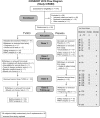In a randomized trial, the live attenuated tetravalent dengue vaccine TV003 is well-tolerated and highly immunogenic in subjects with flavivirus exposure prior to vaccination
- PMID: 28481883
- PMCID: PMC5436874
- DOI: 10.1371/journal.pntd.0005584
In a randomized trial, the live attenuated tetravalent dengue vaccine TV003 is well-tolerated and highly immunogenic in subjects with flavivirus exposure prior to vaccination
Abstract
Infection caused by the four serotypes of dengue virus (DENV-1-4) is a leading cause of mosquito-borne disease. Clinically-severe dengue disease is more common when secondary dengue infection occurs following prior infection with a heterologous dengue serotype. Other flaviviruses such as yellow fever virus, Japanese encephalitis virus, and Zika virus, can also elicit antibodies which are cross-reactive to DENV. As candidate dengue vaccines become available in endemic settings and for individuals who have received other flavivirus vaccines, it is important to examine vaccine safety and immunogenicity in these flavivirus-experienced populations. We performed a randomized, controlled trial of the National Institutes of Health live attenuated tetravalent dengue vaccine candidate (TV003) in fifty-eight individuals with prior exposure to flavivirus infection or vaccine. As in prior studies of this vaccine in flavivirus-naive volunteers, flavivirus-experienced subjects received two doses of vaccine six months apart and were followed closely for clinical events, laboratory changes, viremia, and neutralizing antibody titers. TV003 was well tolerated with few adverse events other than rash, which was predominately mild. Following one dose, 87% of vaccinees had an antibody response to all four serotypes (tetravalent response), suggesting a robust immune response. In addition, 76% of vaccinees were viremic; mean peak titers ranged from 0.68–1.1 log10 PFU/mL and did not differ by serotype. The second dose of TV003 was not associated with viremia, rash, or a sustained boost in antibody titers indicating that a single dose of the vaccine is likely sufficient to prevent viral replication and thus protect against disease. In comparison to the viremia and neutralizing antibody response elicited by TV003 in flavivirus-naïve subjects from prior studies, we found that subjects who were flavivirus-exposed prior to vaccination exhibited slightly higher DENV-3 viremia, higher neutralizing antibody titers to DENV-2, -3, and -4, and a higher tetravalent response frequency after TV003 administration. In summary, we demonstrate that the NIH tetravalent dengue vaccine TV003 is well-tolerated in flavivirus-experienced individuals and elicits robust post-vaccination neutralizing antibody titers.
Trial registration: ClinicalTrials.gov NCT01506570.
Conflict of interest statement
The authors have declared that no competing interests exist.
Figures



Similar articles
-
Robust and Balanced Immune Responses to All 4 Dengue Virus Serotypes Following Administration of a Single Dose of a Live Attenuated Tetravalent Dengue Vaccine to Healthy, Flavivirus-Naive Adults.J Infect Dis. 2015 Sep 1;212(5):702-10. doi: 10.1093/infdis/jiv082. Epub 2015 Mar 22. J Infect Dis. 2015. PMID: 25801652 Free PMC article. Clinical Trial.
-
Safety and immunogenicity of the tetravalent, live-attenuated dengue vaccine Butantan-DV in adults in Brazil: a two-step, double-blind, randomised placebo-controlled phase 2 trial.Lancet Infect Dis. 2020 Jul;20(7):839-850. doi: 10.1016/S1473-3099(20)30023-2. Epub 2020 Mar 24. Lancet Infect Dis. 2020. PMID: 32220283 Clinical Trial.
-
Safety and Immunogenicity of a Live Attenuated Tetravalent Dengue Vaccine Candidate in Flavivirus-Naive Adults: A Randomized, Double-Blinded Phase 1 Clinical Trial.J Infect Dis. 2015 Oct 1;212(7):1032-41. doi: 10.1093/infdis/jiv179. Epub 2015 Mar 19. J Infect Dis. 2015. PMID: 25791116 Free PMC article. Clinical Trial.
-
Development of a recombinant, chimeric tetravalent dengue vaccine candidate.Vaccine. 2015 Dec 10;33(50):7112-20. doi: 10.1016/j.vaccine.2015.11.022. Epub 2015 Nov 14. Vaccine. 2015. PMID: 26585500 Review.
-
A recombinant, chimeric tetravalent dengue vaccine candidate based on a dengue virus serotype 2 backbone.Expert Rev Vaccines. 2016;15(4):497-508. doi: 10.1586/14760584.2016.1128328. Epub 2016 Feb 22. Expert Rev Vaccines. 2016. PMID: 26635182 Review.
Cited by
-
Immunogenicity and Safety of a Tetravalent Recombinant Subunit Dengue Vaccine in Adults Previously Vaccinated with a Live Attenuated Tetravalent Dengue Vaccine: Results of a Phase-I Randomized Clinical Trial.Am J Trop Med Hyg. 2020 Aug;103(2):855-863. doi: 10.4269/ajtmh.20-0042. Epub 2020 May 7. Am J Trop Med Hyg. 2020. PMID: 32394880 Free PMC article. Clinical Trial.
-
Opportunities and challenges of mRNA technologies in development of dengue virus vaccine.Front Immunol. 2025 Mar 5;16:1520968. doi: 10.3389/fimmu.2025.1520968. eCollection 2025. Front Immunol. 2025. PMID: 40109333 Free PMC article. Review.
-
Localized Inflammation in Dengue Vaccine-Induced Skin Rash Is Not Associated with Continuous Presence of Dengue Virus Genome.J Invest Dermatol. 2025 Aug;145(8):2021-2033.e3. doi: 10.1016/j.jid.2024.11.015. Epub 2024 Dec 27. J Invest Dermatol. 2025. PMID: 39733933
-
RNA Structure Duplication in the Dengue Virus 3' UTR: Redundancy or Host Specificity?mBio. 2019 Jan 8;10(1):e02506-18. doi: 10.1128/mBio.02506-18. mBio. 2019. PMID: 30622191 Free PMC article.
-
Hit-to-Lead Short Peptides against Dengue Type 2 Envelope Protein: Computational and Experimental Investigations.Molecules. 2022 May 18;27(10):3233. doi: 10.3390/molecules27103233. Molecules. 2022. PMID: 35630712 Free PMC article.
References
-
- Beatty ME, Stone A, Fitzsimons DW, Hanna JN, Lam SK, Vong S, et al. Best practices in dengue surveillance: a report from the Asia-Pacific and Americas Dengue Prevention Boards. PLoS Negl Trop Dis. 2010;4(11):e890 Epub 2010/11/26. PubMed Central PMCID: PMC2982842. doi: 10.1371/journal.pntd.0000890 - DOI - PMC - PubMed
-
- (PAHO/WHO) PAHOWHO. Five-fold increase in dengue cases in the Americas over the past decade Washington, D.C.2014, May 29. Available from: http://www.paho.org/hq/index.php?option=com_content&view=article&id=9657....
-
- Kraemer MU, Sinka ME, Duda KA, Mylne AQ, Shearer FM, Barker CM, et al. The global distribution of the arbovirus vectors Aedes aegypti and Ae. albopictus. Elife. 2015;4:e08347 PubMed Central PMCID: PMCPMC4493616. doi: 10.7554/eLife.08347 - DOI - PMC - PubMed
-
- Simmons CP, Farrar JJ, Nguyen v V, Wills B. Dengue. N Engl J Med. 2012;366(15):1423–32. Epub 2012/04/13. doi: 10.1056/NEJMra1110265 - DOI - PubMed
-
- Sabin A. Research on dengue during World War II. Am J Trop Med Hyg. 1952;1(1):30–50. - PubMed
Publication types
MeSH terms
Substances
Associated data
Grants and funding
LinkOut - more resources
Full Text Sources
Other Literature Sources
Medical
Research Materials

